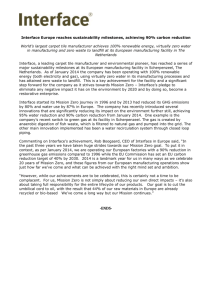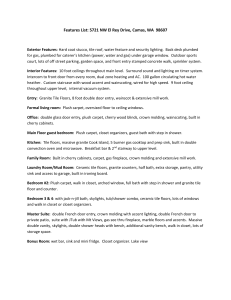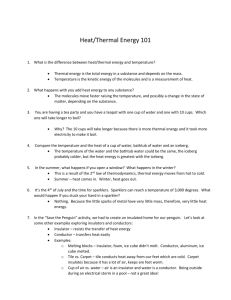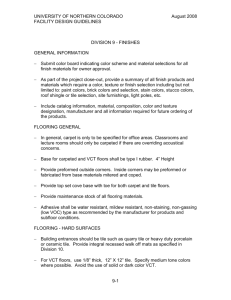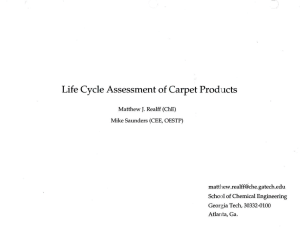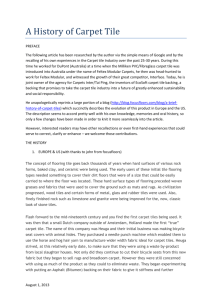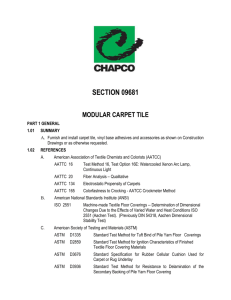Thermal Energy - Ohio Energy Project
advertisement
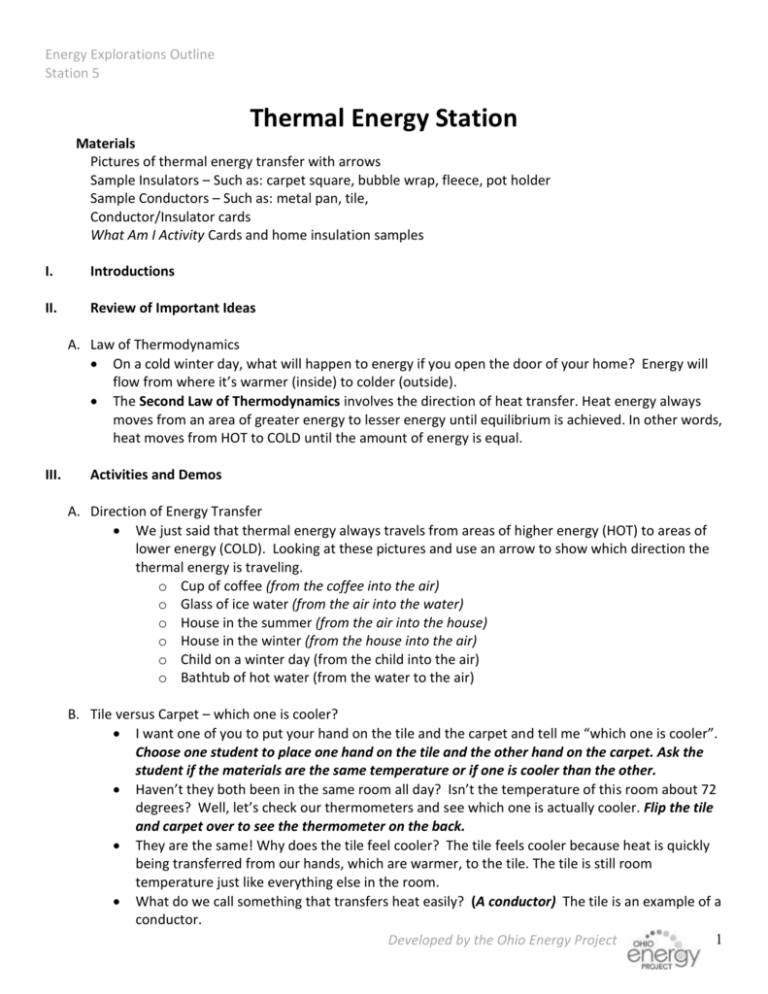
Energy Explorations Outline Station 5 Thermal Energy Station Materials Pictures of thermal energy transfer with arrows Sample Insulators – Such as: carpet square, bubble wrap, fleece, pot holder Sample Conductors – Such as: metal pan, tile, Conductor/Insulator cards What Am I Activity Cards and home insulation samples I. Introductions II. Review of Important Ideas A. Law of Thermodynamics On a cold winter day, what will happen to energy if you open the door of your home? Energy will flow from where it’s warmer (inside) to colder (outside). The Second Law of Thermodynamics involves the direction of heat transfer. Heat energy always moves from an area of greater energy to lesser energy until equilibrium is achieved. In other words, heat moves from HOT to COLD until the amount of energy is equal. III. Activities and Demos A. Direction of Energy Transfer We just said that thermal energy always travels from areas of higher energy (HOT) to areas of lower energy (COLD). Looking at these pictures and use an arrow to show which direction the thermal energy is traveling. o Cup of coffee (from the coffee into the air) o Glass of ice water (from the air into the water) o House in the summer (from the air into the house) o House in the winter (from the house into the air) o Child on a winter day (from the child into the air) o Bathtub of hot water (from the water to the air) B. Tile versus Carpet – which one is cooler? I want one of you to put your hand on the tile and the carpet and tell me “which one is cooler”. Choose one student to place one hand on the tile and the other hand on the carpet. Ask the student if the materials are the same temperature or if one is cooler than the other. Haven’t they both been in the same room all day? Isn’t the temperature of this room about 72 degrees? Well, let’s check our thermometers and see which one is actually cooler. Flip the tile and carpet over to see the thermometer on the back. They are the same! Why does the tile feel cooler? The tile feels cooler because heat is quickly being transferred from our hands, which are warmer, to the tile. The tile is still room temperature just like everything else in the room. What do we call something that transfers heat easily? (A conductor) The tile is an example of a conductor. 1 Developed by the Ohio Energy Project What about the carpet? If the tile is a conductor, then what do you think the carpet is? Carpet feels the same because it has lots of air spaces and resists the transfer of heat so our hand does not transfer heat to the carpet rapidly like the tile. What do we call something that resists heat easily? (An insulator) The carpet is an example of an insulator. C. More Insulators and Conductors - For each of the following items, I would like for you to move around the table and feel each one and ask yourself - does it feel cooler, or the same temperature? Once the students have all had a turn to place their hand on each material, distribute the Conductor/Insulator cards and help them use the cards to label each material. Discuss: what do the insulators all have in common? (They all contain air pockets…) Metal pan, water, tile – conductors Pot holder, bubble wrap, fleece, cup of air, cork or weather stripping – insulators Which one is both a conductor and an insulator? Pan with rubber handle (The pan conducts heat to the food but the handle insulates your hand from being burned.) D. What Am I Activity – Match the word to the definition and actual insulation item. Discuss why these are important places to put insulation. Weather Stripping-I come in a roll and am used around door frames and windows to seal air leaks Draft Stopper-I am a rectangular piece of foam inserted behind switch and outlet covers to stop air leaks Pipe Insulation-I am a foam tube placed around hot water pipes to reduce energy loss. Door Sweep-I am placed along the bottom of an outside door to stop air leaks and save energy. Solar Window Film-I am applied to glass to block UV rays, reflect glare and repel heat in warm climates. Fiberglass Insulation-I am usually pink or yellow and used to keep energy from entering or leaving your home. IV. Closure Fill in leadership guide Straighten up, re- set Leadership Guide Question: Thermal energy (or heat) always flows from ______HOT______ to ______COLD______ until equal. Developed by the Ohio Energy Project 2
